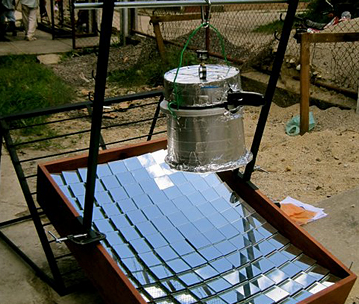Related Resources: Engineers Edge
Medical equipment is sterilized using solar concentrating system
Engineering Design and Technology News Home
In that nation, a mostly rural population of six million is served by some 11 hospitals, dozens of health centers, and some 1,300 “health posts” that provide emergency care, obstetric services and the occasional baby delivery. Most of these posts, staffed by nurse practitioners, either lack equipment to sterilize surgical tools and bandages or have kerosene-powered autoclaves. Often, nurses resort to boiling tools or swabbing them with alcohol, or must travel long distances for proper sterilization at larger centers or hospitals.
But an MIT team called the Little Devices group, part of the Institute’s D-Lab series of classes, workshops and labs, has developed an alternative called SolarClave, a solar-powered autoclave that can be built and repaired using locally available parts and materials. The device would cost less than existing kerosene or electric sterilizers and would require no fuel or power.
The device, explains Anna Young, a D-Lab Scale-Ups Fellow and leader of the SolarClave project, is an example of a different approach to creating technologies for use in the developing world: Rather than having teams of engineers in a place like Cambridge come up with an invention, and then try to get people in developing countries to use it, the D-Lab group emphasizes an interactive approach in which end-users play an integral role in developing and refining a product.
 |
| SolarClave device. Photo courtest os Anna Young and Jose Marquez |
SolarClave is an example of that process in action, Young says. In the more than three years it has been under development, “the design has changed drastically” in response to feedback from users at the health posts in Nicaragua.
The changes have simplified the design, making it easier to build and less prone to failure; improved its safety by reducing the number of connections where hot steam might leak out; and increased the number of components available in Nicaragua.
An early prototype used a boiler suspended over a foil-covered parabolic reflector. From that boiler, tubing carried steam to a sterilizing vessel several feet away. But in tests in Nicaragua, the team soon found problems with the system: The foil was vulnerable to damage and hard to replace locally, and the tubing that carried the steam was inefficient, and prone to leakage and damage.
Over time, they arrived at a much more robust system: The unwieldy tubing system was replaced by an ordinary pressure cooker, suspended directly over the reflector, to contain the tools and materials being sterilized. The reflector is now an array of small pocket mirrors, which are readily available in Nicaragua and less prone to damage. “If a rock falls on a mirror, just the mirror breaks, not the whole array,” Young says.
The upgraded system is now is use at three test locations in Nicaragua; by this summer, the team plans to put several more units in use. The next step will be to work with a Nicaraguan company to manufacture and sell the devices.
“It will be made using local supply chains,” Young says, “and it is easily repairable and modifiable.” Users will be able to adapt the system based on their own experience with it and on local availability of parts and materials.
The system delivers heat and pressure that meet sterilization standards set by the U.S. Centers for Disease Control — standards widely adopted by health agencies around the world, Young says. Under a clear sky, the system takes 45 to 60 minutes to heat the pressure cooker to the required temperature — 121 degrees Celsius — then 20 minutes to carry out the sterilization. Typically, at a village health post, the device would run through this cycle about three times a week, she says.
Once the devices have been fully tested in Nicaragua, Young says, she expects the project will expand to other areas in Central America and Africa. “We’re looking for local partners,” she says, “and we’ll be able to license the device to them, and work with them on installation and assembly.”
Modified from materials provided by MIT News Office
Link to this Webpage:
© Copyright 2000 -
2024, by Engineers Edge, LLC
www.engineersedge.com
All rights reserved
Disclaimer |
Feedback
Advertising
| Contact